What is Scotland famous for? … Tartan and the Kilt
Sounds like a great name for a pub, don’t you think? Tartan was first recorded in Scotland circa 1540, a fabric production and design originating in the Highlands. The fabric is made of twill woven sheep’s wool. The communities are known for their weaving; the fabric is made of a distinctive horizontal and vertical stripes and squares pattern known as a “sett”. The design of these stripes and background colour is also referred to as the tartan. A Scottish fashion statement. In the modern world you can see it featured prominently in interior designs or on the catwalk of Burberry and Vivienne Westwood.
Originally, clans people would maximise their animal stock for warmth and food. The crofters would shear the fleece, spin it into wool fibre and dye it. The multiple colours came from local plants, mosses and berries. Don’t attribute special meaning to any of the original colours. This is all a modern-day myth. One such tale is that red tartans were ‘battle tartans’ designed to mask the colour of bloodshed.
The Kilt is a mysterious piece of clothing. It has been around since the 16th century and is essentially a wraparound skirt for a man. Scottish men have no problem wearing a skirt because, well, they’re Scottish and this is one very important tradition. The kilt is durable and long-lasting; an untailored 5 metre-long a piece of tartan, worn around the waist usually worn with a sporran – a small bag worn around the waist, over the kilt. Sporran is the Gaelic word for purse. A Sgian dubh (pronounced skee-an doo), a small dagger, sits in the sock.
NB If you’re expecting all the men in Scotland to be walking the streets in kilts, you’re going to be disappointed. Kilts are expensive pieces of clothing. As such they are generally reserved for special occasions such as weddings (unless you work as a tourist guide!)
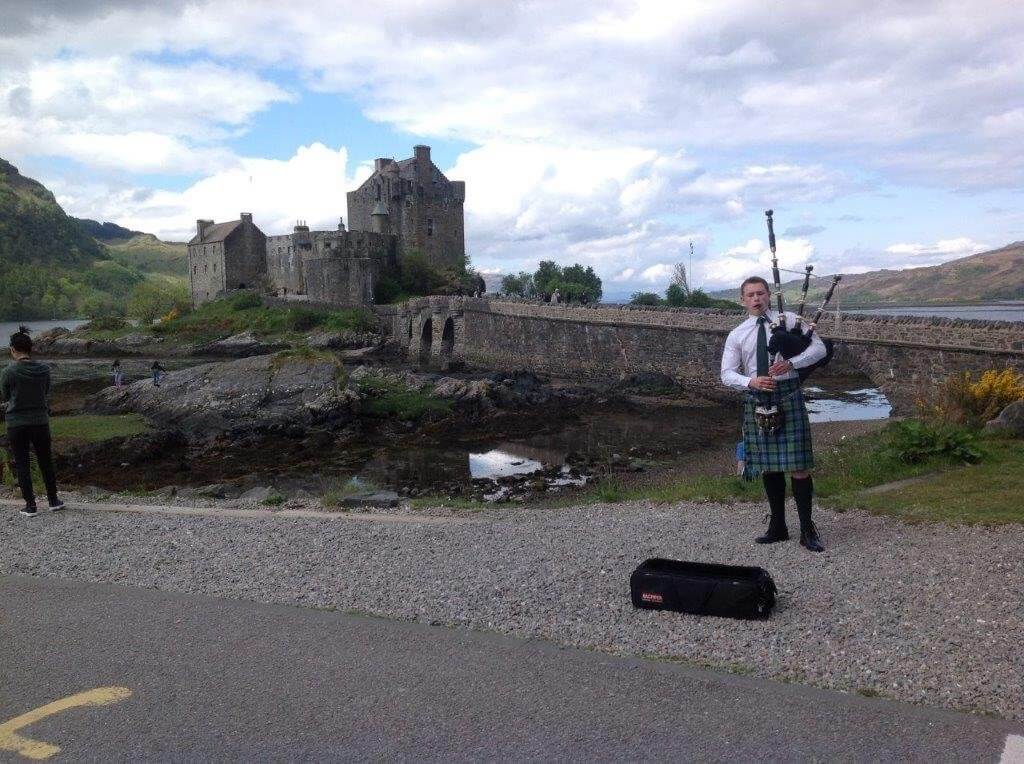
In the past, the long length of fabric was deliberate to enable the wearer to fashion a 3rd of the fabric over the shoulder. This upper section could be adjusted depending on the weather and temperature. The kilt became much more popular in the 21st century after being chosen as uniform by Highland regiments of the British Army.
The naming and registering of clan tartans began in April 1815; the Highland Society of London resolved that all the clan chiefs “be respectfully solicited to furnish the Society with as much of the Tartan of his Lordship’s Clan as will serve to Show the Pattern and to Authenticate the Same by Attaching Thereunto a Card bearing the Impression of his Lordship’s Arms.” Many had no absolute idea of what their tartan might be but were keen to comply and to provide authentic signed and sealed samples.
Today tartan and “clan tartan” is an important part of a Scottish clan. Almost all Scottish clans have several tartans attributed to their name. Several clans have “official” tartans. It is possible for anyone to create a tartan and name it as they wish however the only person with the authority to make a clan’s tartan “official” is the chief. If you’ve a design of your own, you can commission your own tartan. You can even submit it to the Scottish Register of Tartans for approval.
If you’re looking for a specific design of tartan, search through the thousands on the Scottish Register of Tartans’ online collection to find your perfect combination and design. Boat of Garten even has its own tartan. Try Kinloch Anderson, they also have a Heritage Room Museum to see the history of the family over 140 years. Visit the Lochcarron Weavers Shop in Loch Carron in Wester Ross, Highlands.
Would you like to see a kilt being made? There is an exhibition in Inverness. If you visit on a weekday, you will see the kiltmakers at work. If you’re there at a weekend, you’ll have to make do with a video presentation, but it is still quite fascinating to visit the exhibition.
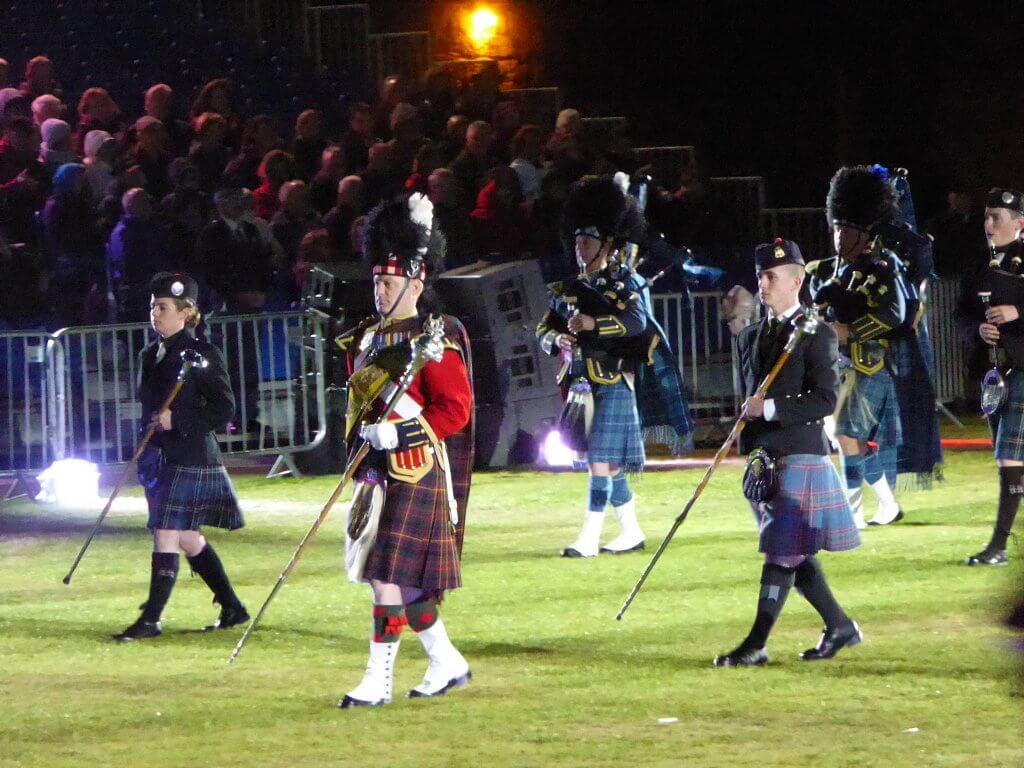
Traditional Scottish kilts are worn in a ceremony.
The very first recorded appearance of the Loch Ness Monster occurred in 565 AD, when a “water beast” attacked one of St. Columba’s followers in the loch. Note, it’s not a lake. Then the not-so-delightful monster went on a holiday.
It is now one of the best modern-day tourist attractions that you’re not actually guaranteed to see!
Our Loch Ness Monster returned and was nicknamed “Nessie”; she first popped up again in 1933 and has been much loved and only a couple of times capture on film. Photographed with her infamous giraffe-like neck peering out of the water… or was it a stick? Unfortunately, even though we’ve more cameras and smartphones visit Loch Ness than ever, we’ve no new photos for decades. Come on, Nessie, we want to see you again.
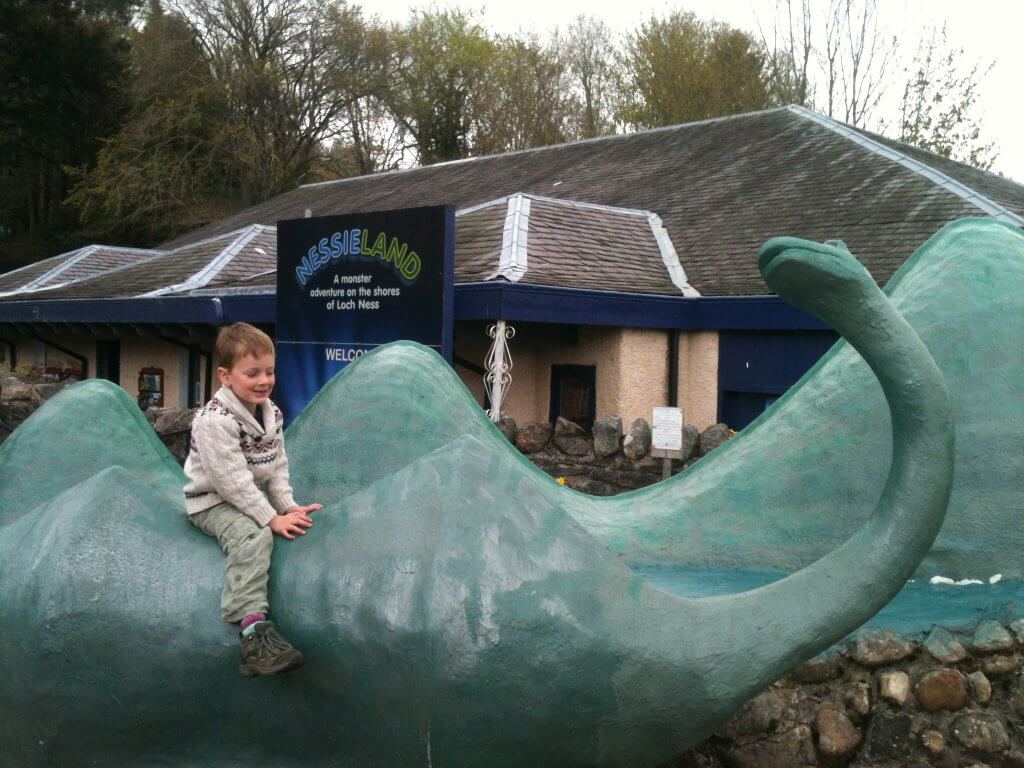
Obviously not the real deal – but perhaps the closest we’ll get to the legend herself
salmon – whisky – castles – golf – textiles – shellfish – military Tattoo – Edinburgh Festival – music – bagpipes and many more
Family adventure vacations mean different things to different families. Our definition is possibly a wee bit on the wild side for some people – but some of our friends have adventures even more out on the wild side than ours. At least if some one else arranges your adventure for you, you have some peace of mind in knowing that they have checked out some of the potential hazards for you. They have probably minimised the risks so you can relax and enjoy the vacation.
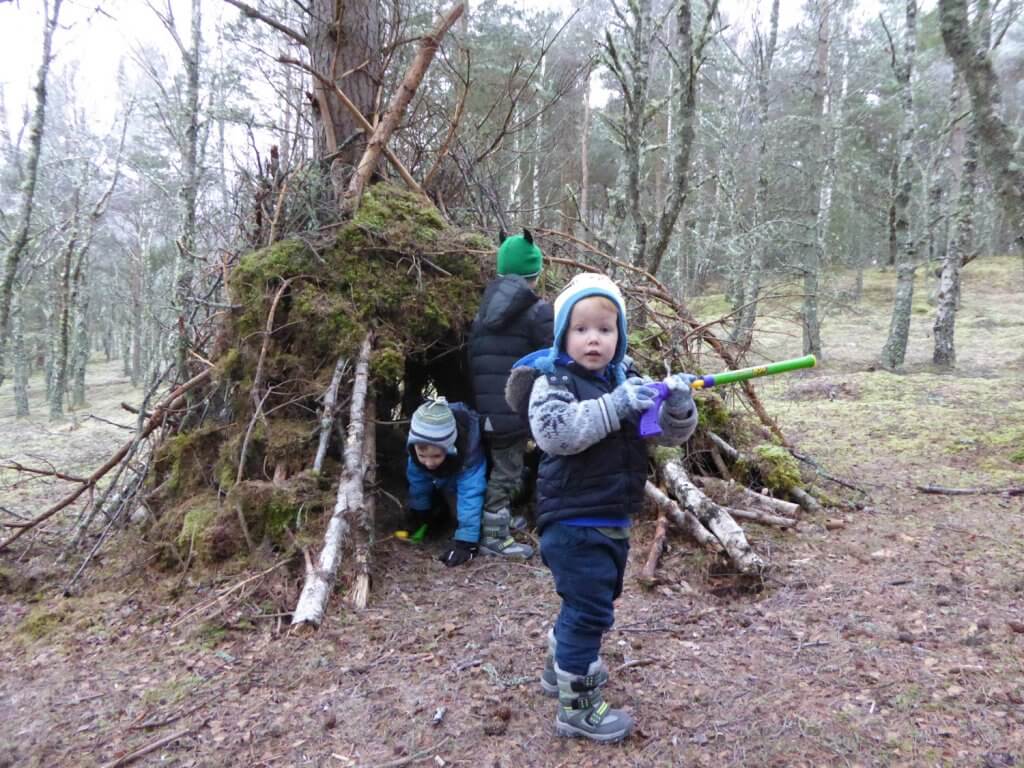 Photo caption: Taken on a different day with different children, but you get the idea. Dens in the wood had a universal appeal.
Photo caption: Taken on a different day with different children, but you get the idea. Dens in the wood had a universal appeal.
Short walk at Loch an Eilean followed by a transfer to Ruthven Barracks and Highland Folk Museum. Tour of Folk Museum.
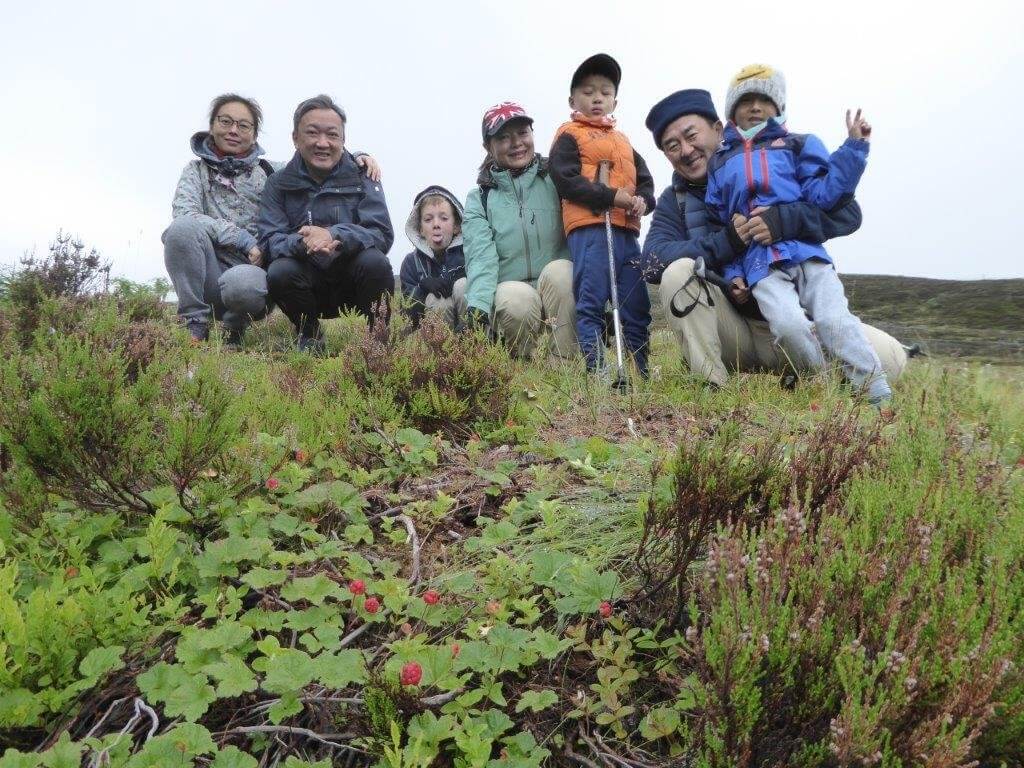
Adventuring we will go – up hill, down dale and thru heather to the berries.
Visit to Highland Wildlife Park to see the polar bears and Amur tigers, & sheepdog demonstrations
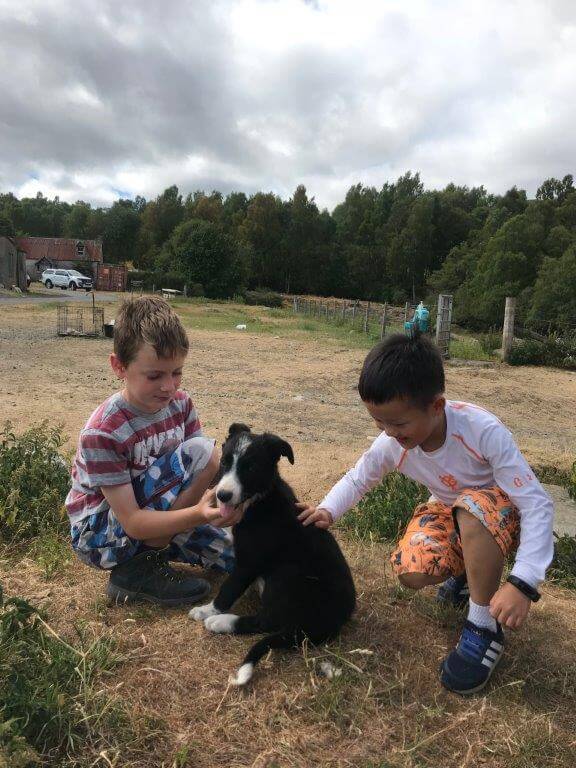
Meeting the puppies after the sheepdog demonstrations here in the Cairngorms National Park
Visit to Speyside Cooperage, Tomatin Distillery and the Whisky Castle
This was a day mainly for the adults as learning all about the making and drinking of whisky didn’t exactly thrill the kids but their day was made by an ice cream stop an a visit to the adventure play park in Tomintoul. For a full whisky explanation read up on our blog about how to choose a special whisky which you won’t find at home. We’ve also talked about all kinds of whisky related products.
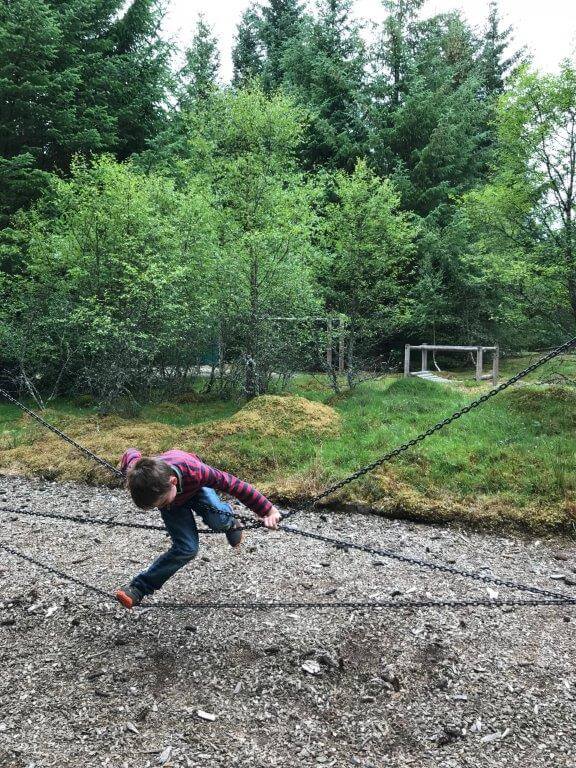
Trying out the obstacles in the adventure play park at Tomintoul which entertains the kids while the whisky tasting goes on at the Whisky Castle.
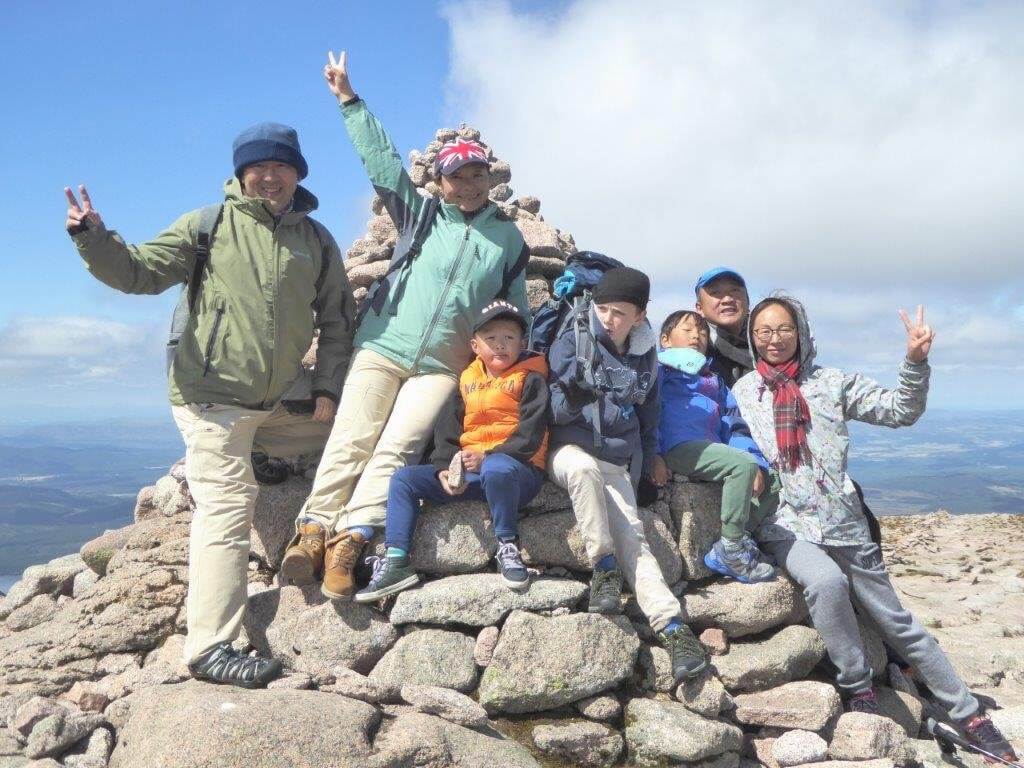
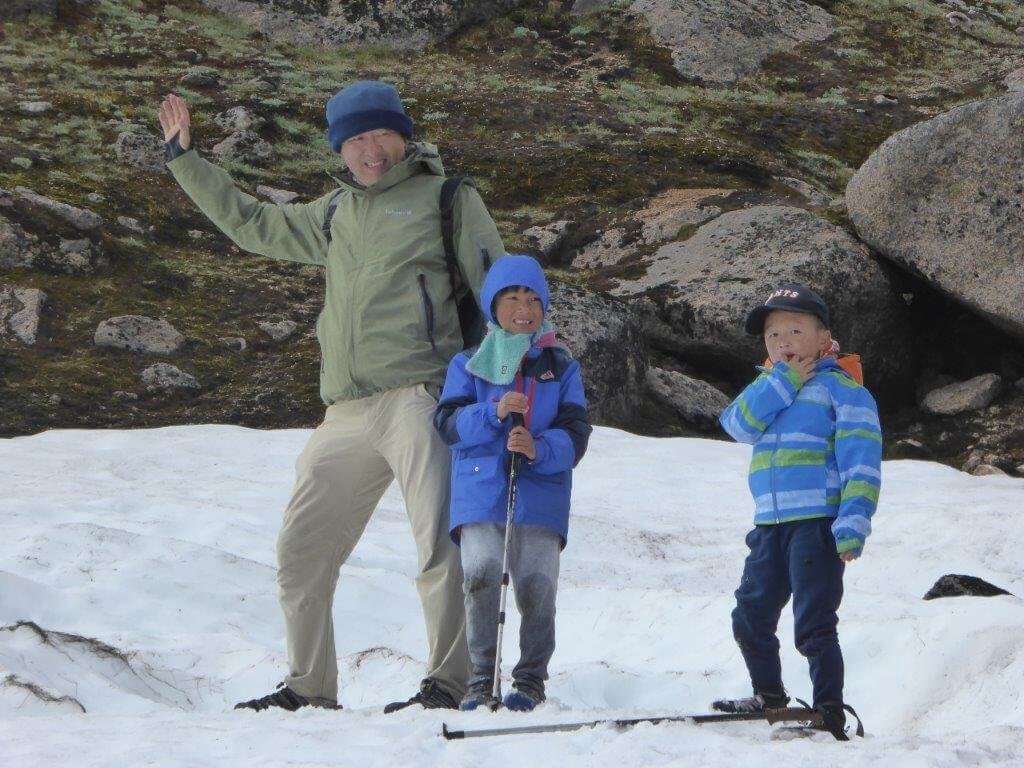
In no particular order we’ve listed 10 of our favourite family walks in the Cairngorms. We’ve concentrated on the area we know best around the northern side of the park, but we do also know of some excellent walks on the south side of the park which we’ll mention in passing with reference to more detailed information at the end of the blog.
We’ve concentrated on walks which you can do with younger children as once your kids reach a certain age, they’re capable of achieving just as much on a day hike as any other adult.

Ascending Meall a’Bhucaille with 2 x 7 year olds and 1 x 4 year old.
Of the family walks available in the Cairngorms, this is one of the most popular, also frequented by some of the minibus tour companies like Rabbies.
The walk takes about 2 hours or 4.5 miles
It is a lovely walk to do. You don’t have to do the whole walk but the path is suitable for push chairs, particularly those with 3 wheels or larger wheel sizes.
The ruined castle on the island in the loch lends the situation a romantic aura. The area has featured in Outlander and the new Netflix extravaganza about King Arthur.
The optional extension around the neighbouring loch, is almost deserted. The path is wide and mostly through lovely open Caledonian pines. Even on a wet day, it is picturesque.
In summer, you can snack your way round on the wild bilberries which line the path in places.
Map of the route, courtesy of Walk Highlands.
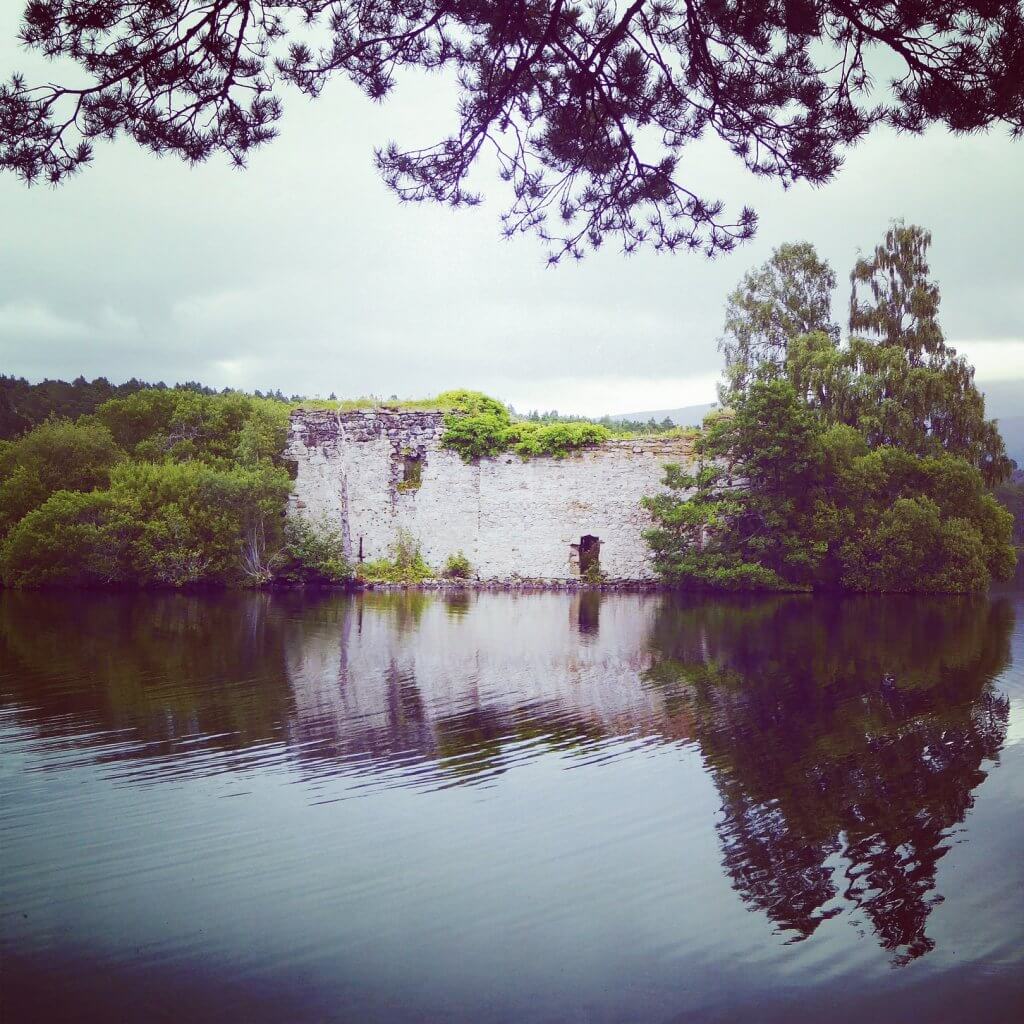
One of the most popular short walks in the northern Cairngorms. (Bilberries are the summer highlight.)
An easy walk to fit into a bigger day of activities. Going up to the Green Lochan and back to your car will only take about 1 hour.
1.2 miles: 26 mins (one way)
Start at Glenmore Lodge or the Forestry Commission Visitor Information Centre in Glenmore. Parking at the end of the road by Glenmore Lodge is limited and on a fine day you may find that there is no space there. If you are parked at the end of the road, near the visitor information centre, you will end the walk at the Cobbs cafe. A cake break here makes a fine reward at the end of the day.
The path is wide and easy to find up to the Green Lochan. It starts from the road end and continues straight up to the Green Lochan. Allow time to stop at the lochan take in the views and maybe even dabble your toes in the water. There’s a great spot for photos too.
If this is not enough of a walk for you and your family the route continues on to Ryvoan Bothy. The Bothy is a basic shelter, like a refuge. It is free to use and does not have a warden. The main thing to remember is that you should not leave anything at the bothy which wasn’t there when you arrived. You can spend the night at Ryvoan Bothy, but be prepared for some competition for the “bed” space. There is a small stove in the bothy, so providing you have fuel, you should be warm enough.
Here’s a link to the map of Walk Highland’s version of this walk which can also be done as a there and back route from your car parked outside Glenmore Lodge for a shorter route.
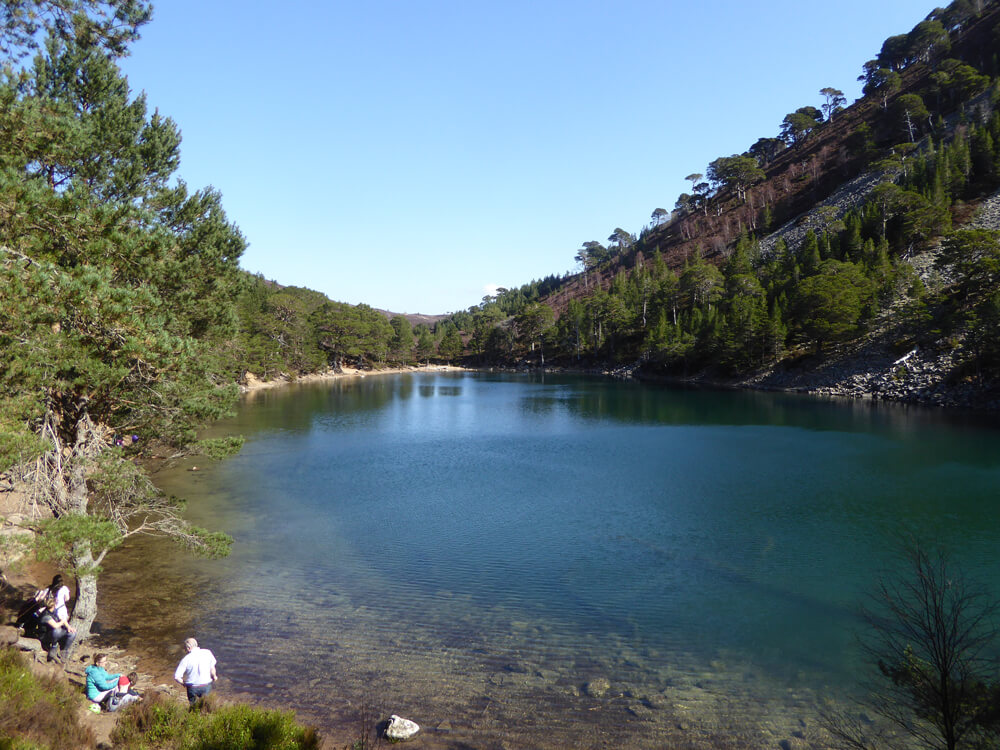
Perfect spot to rest up after a wee walk. Popular in the middle of the day.
This is a lovely walk at any time of year in almost any weather conditions. The majority of the walk is through mature Caledonian pine forest which bears no resemblance whatsoever to commercial forestry. The trees are not all straight nor are they planted in rows. The undergrowth is lush and often filled with treasures like wild blueberries, cowberries or mushrooms. You could see a red squirrel, roe deer, crested tits, ospreys etc
At Loch Garten you have the option of visiting the Osprey Hide and hearing the ongoing saga of the Osprey centre (April to August only).
Including Loch Mallachie on your circuit is a must. It is a beautiful spot and really quite peaceful. Sunrise is glorious here if you’re an early riser.
2 – 3 hours: 9km, plus walk through Boat of Garten to the car park if you are starting from Fraoch Lodge
Map courtesy of Walk Highlands
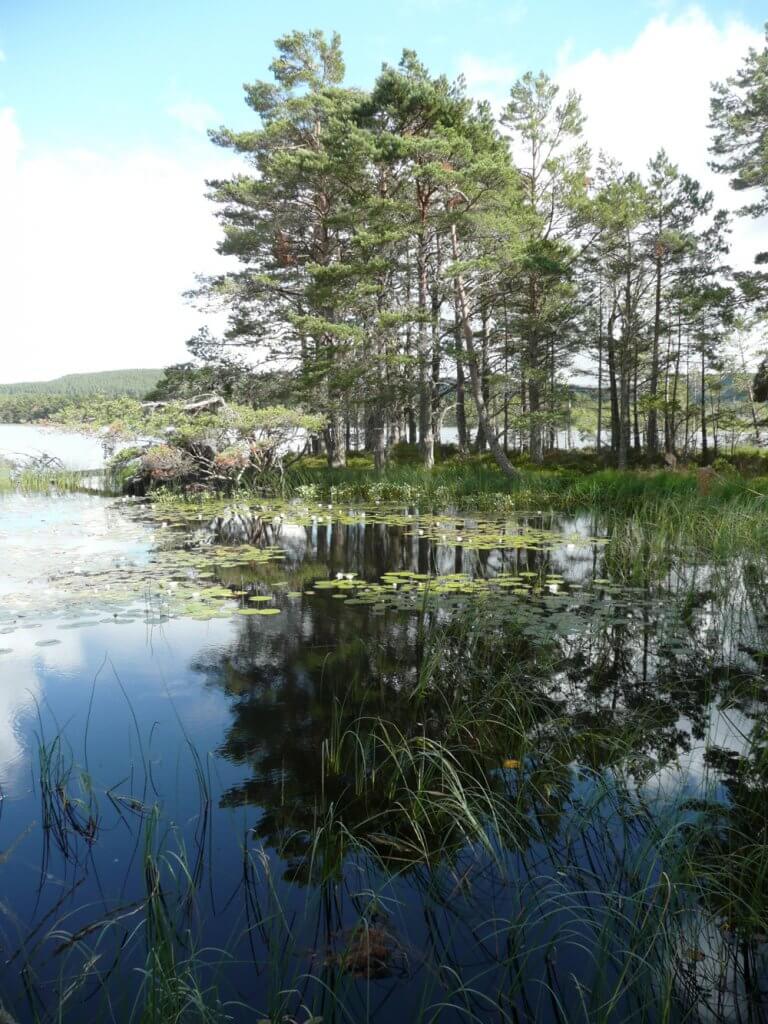
The peaceful scenery of Loch Mallachie, near Boat of Garten
This is a short way-marked circular route of 5km.
You’ll start either from the centre of Grantown, or from the caravan park (though parking is limited here). The route starts on a tarmaced track leading off left past the caravan park. You’ll then pick up signs for the Dava Way and the viewpoint walk to the right. Follow the track up the hill along the side of the stream. You’ll pass a couple of points where you can admire the view over Grantown to the Cromdale hills before reaching the ultimate viewpoint marker, atop a small rocky outcrop. Here you’ll find a viewpoint marker indicating all the mountains etc you can see.
Continue on from the viewpoint to make the walk a circular route, finishing up along the old railway track which is now part of the Dava Way.
There are opportunities to Geocache along the way if you feel the need to add a bit of interest to the walk.
For a full route description try Walk Highlands
This is a really short walk suitable for even the youngest members of the family. It follows the river Nethy from the bridge in the centre of Nethybridge up towards the Dell of Abernethy. There are also plenty of opportunities to extend the walk along the local network of paths, the majority of which are waymarked.
You can also pick up a map at the information centre in the village hall right at the start of your walk.
There are alternative routes out to Broomhill station and Castle Roy on the other side of Nethybridge.
Take the steam train from Boat of Garten to Broomhill. Follow the walking route into Nethybridge and either pick you way to the river where there is a wee beach where you can relax. You can paddle in the shallows too. But watch out, because there are deeper patches in the middle of the river. Don’t try to wade out to the other side.
From here you could also pick up the Speyside way and walk all the way back to Boat of Garten which is no more than 5 miles and probably less. It’s a great walk with plenty of opportunities in the summer to stop and snack on bilberries (wild blueberries).
There are plenty of Geocache possibilities in Nethybridge too to keep the kids focused.
Ellan Woods are again filled with Geocache boxes. Even if you don’t travel that far, the kids will have a great time trying to retrieve as many prizes as they can.
Parts of the off-road route 7 cycle path also pass through Carrbridge.
If you’re looking for a longer alternative, we do include a Carrbridge circuit in our self-guided Cairngorm itinerary. You could also take a look at the week long itinerary of self-guided walks: we could adapt this trip for your group.
Sluggan bridge as a walk on it’s own is suitable for almost anyone to do. It is just a quick stretch of the legs, but can easily be extended and is such as lovely spot that you can easily spend an afternoon there with the kids. Dabble in the water and have a picnic.
This is a wee favourite of ours. A little jaunt up to a viewpoint above Aviemore, or if you have really wee ones just go to the wee lochans. You’d hardly know you’re right next to the A9.
The walk is about 5km so probably not one for really young ones. Parts of it were a wee bit icy when we did it (admittedly that was March and really only to be expected). Lovely walk which breaks out of the birch forest to provide spectacular views as below. Some steep sections but easily managed by anyone of moderate fitness. Walking poles advised if you are not used to hill walking.
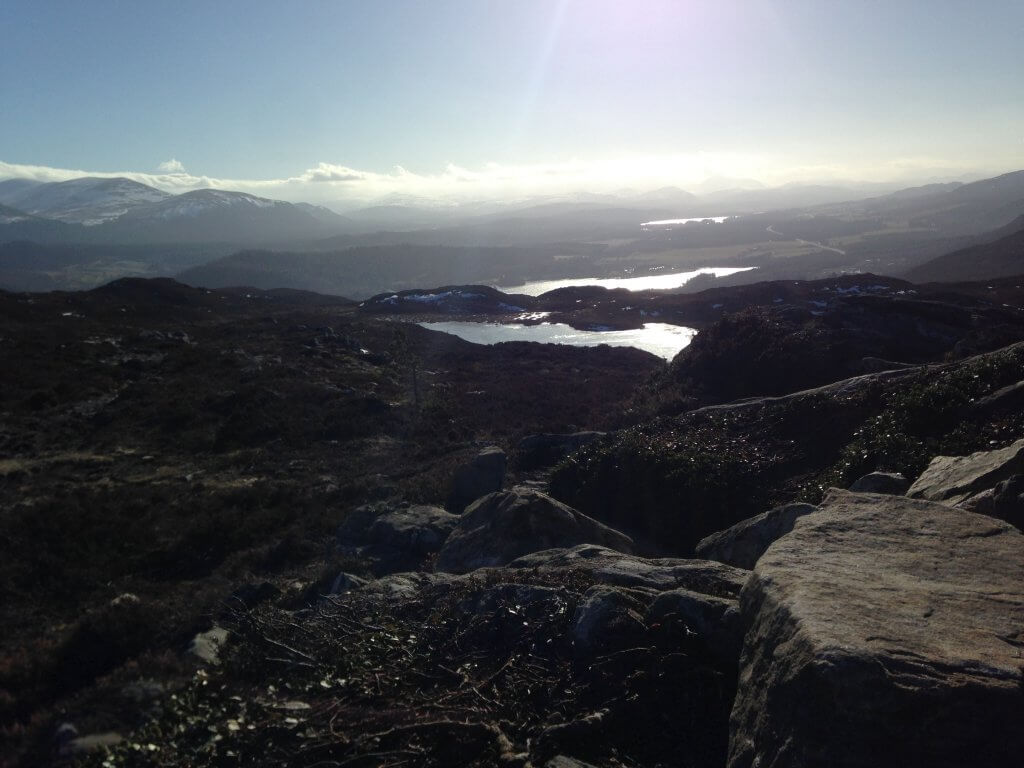
Spectacular and unusual views from the viewpoint above Craigellachie Nature Reserve
Well worth a wee gander across the moor to Aviemore. You follow the route of the Strathspey Railway most of the way to Aviemore as well as the course of the river Spey. This is part of the Speyside Way. It is a well maintained wide path. You’ll be heading towards the Cairngorms so spectacular views of the mountains. The only downside is that there is very little shelter for the majority of the route though the beginning and the end are protected by trees.
Points of interest:
You can come out into Aviemore on the Dalfaber estate, right next to Cairngorm Brewery. Worth a stop? They do brewery tours! Also near here: Kilted Fudge (for the kids to pick up a treat) and Route 7 Cafe.
You can return by steam train to Boat of Garten if you time it right, or alternatively take the public bus service (no. 34) back to the village.
5 to 6 miles, depending on how far into Aviemore you go.
We’ve already covered this option in some detail in a previous blog. Do click on the link for full details. This is a very popular family walk. Plenty of treats for the younger kids to encourage them to the top.
This is quite a walk for wee kids, but don’t forget if it’s your first attempt and the kids get tired, you usually have the option of taking the funicular train back down (providing you remember your wallet).
Again it is easy to extend this walk if you want or keep it short and just pop in at the Ptarmigan restaurant at the top for snacks and refreshments.
Do not attempt this walk with young kids in the winter months.
From the ski car park to the summit is: just over 4km, 2 – 2.5 hr walking
Remember: there is no shelter or shade on this walk. Cairngorm is sub-arctic tundra. Most of the vegetation is less than knee high. There are trees but they are of the dwarf variety and don’t even reach you knees. You’d have to know what you’re looking at to identify them as trees!
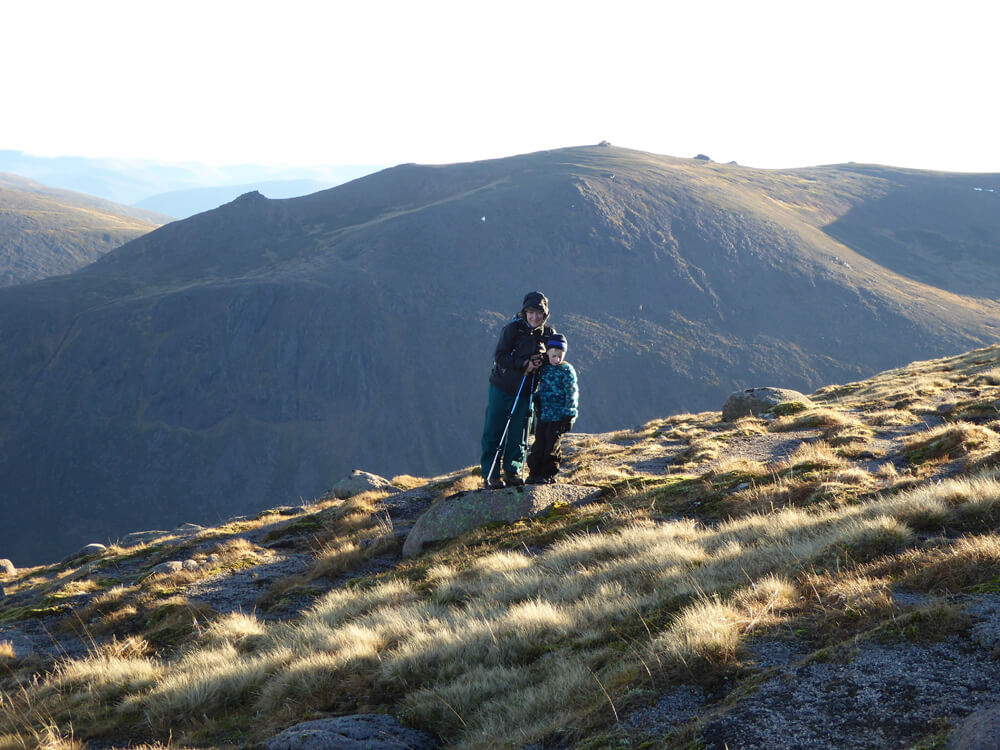
A family day out on the summit of Cairngorm (with diversions to hunt for snow)
For maps and full route descriptions try WalkHighlands
For leaflets on the community trails around many of the villages in the Cairngorms click here
Visit Scotland’s suggestions for scenic family walks
Best hikes in the Cairngorms from the Guardian.
https://blog.visitcairngorms.com/six-great-walks-beginners-families/
family adventures in the Cairngorms aimed at kids aged 5 – 12

Ascending Meall a’Bhucaille with 2 x 7 year olds and 1 x 4 year old.
Family adventures in the Cairngorms might not have the sea and golden beaches (we’ve only the one at Loch Morlich), but there is such a lot you can do with your kids here in the Cairngorms National Park, that some families return year after year.
Have a look at the various options we suggest below. We’ve picked a variety at a range of price points.
Taking a guided family adventure with Scot Mountain Holidays
Cairngorm Discovery – explore Britain’s largest National Park with our guidance. Enjoy some fabulous activities including some biking, some hiking and some more gentle creative pursuits like “throwing a pot” and creating your own wool at a small traditional mill.
Highland Family Adventure – for a full on introduction to the great outdoors. Enjoy some family time on hikes and wee bike rides throughout the Highlands. Visit Loch Ness. Enjoy the remote but spectacular scenery in Torridon. A mix of guided and self-guided activities for all the family to enjoy. Itinerary adaptable – call for personal quote.
Under Your Own Steam – best suited for the younger end of the age group, but routes can be adapted and lengthened to provide more of a challenge if your kids are keen cyclists.
Tailor-made Active Highland Tour – this area, the Cairngorms National Park, is the UK’s greatest outdoor playground. There is a lifetime of outdoor enjoyment here – on foot, by bike, gliding or canoeing. There should be something to suit everyone except the least active. It’s a great opportunity to get the kids outside enjoying nature. We can select from a massive range of activities and experiences to put together a tour to appeal to all the family from flying through the trees on a zip wire to outdoor treasure hunting or indoor pottery – there should be something for all – especially nature and wildlife lovers.
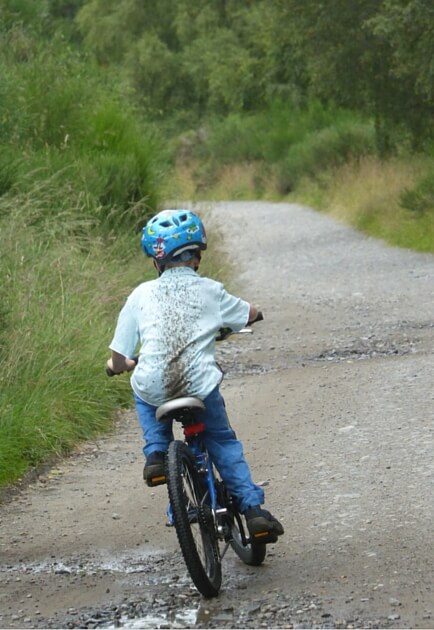
Family mountain biking in the Cairngorms
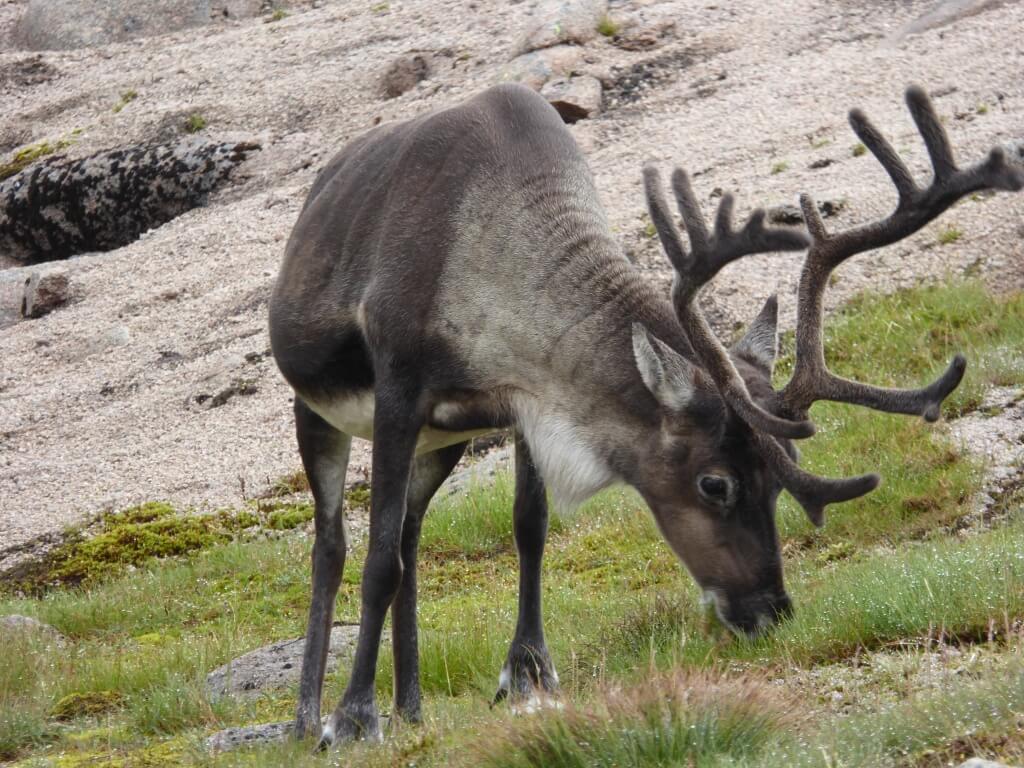
Visit the Cairngorm Reindeer herd in the natural environment (Cairngorms)
Zip wire – Treezone – River tubing – Gorge walking – Pony trekking – Landmark Forest Adventure Park – feed the deer – feed the reindeer ……
Contact us for full details or to include on your tour.

Chowing down in the Tentipi
All content © Copyright Scot Mountain Holidays 2025
Responsive web design by Summit Web Solutions